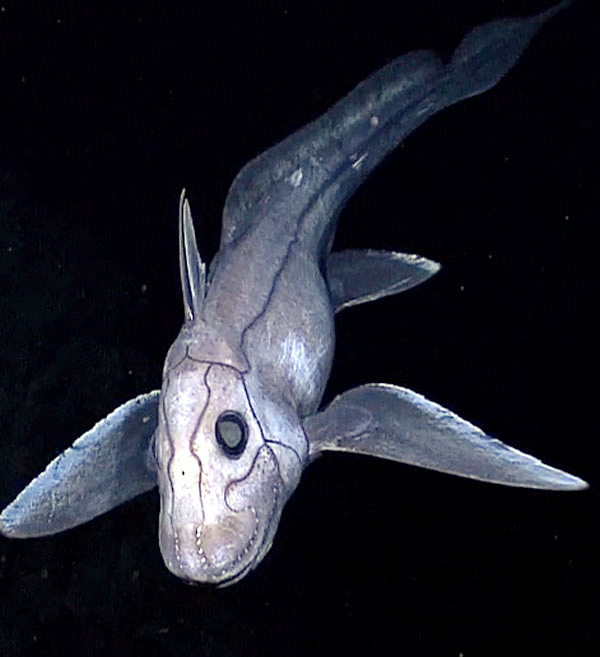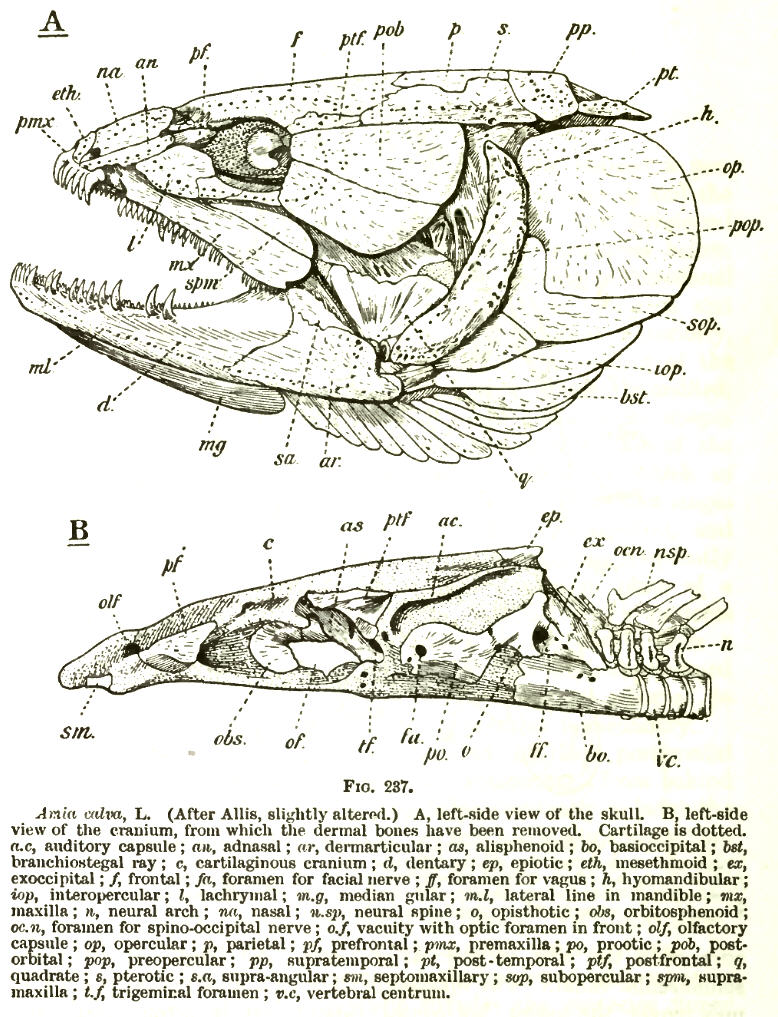|
Operculum (fish)
The operculum is a series of bones found in bony fish and chimaeras that serves as a facial support structure and a protective covering for the gills; it is also used for respiration and feeding. Anatomy The opercular series contains four bone segments known as the preoperculum, suboperculum, interoperculum and operculum. The preoperculum is a crescent-shaped structure that has a series of ridges directed posterodorsally to the organism’s canal pores. The preoperculum can be located through an exposed condyle that is present immediately under its ventral margin; it also borders the operculum, suboperculum, and interoperculum posteriorly. The suboperculum is rectangular in shape in most bony fish and is located ventral to the preoperculum and operculum components. It is the thinnest bone segment out of the opercular series and is located directly above the gills. The interoperculum is triangular shaped and borders the suboperculum posterodorsally and the preoperculum anterodo ... [...More Info...] [...Related Items...] OR: [Wikipedia] [Google] [Baidu] [Amazon] |
Bony Fish
Osteichthyes ( ; ), also known as osteichthyans or commonly referred to as the bony fish, is a Biodiversity, diverse clade of vertebrate animals that have endoskeletons primarily composed of bone tissue. They can be contrasted with the Chondrichthyes (cartilaginous fish) and the extinct placoderms and acanthodians, which have endoskeletons primarily composed of cartilage. The vast majority of extant taxon, extant fish are members of Osteichthyes, being an extremely diverse and abundant group consisting of 45 order (biology), orders, over 435 family (biology), families and 28,000 species. The group is divided into two main clades, the ray-finned fish (Actinopterygii, which makes up the vast majority of extant fish) and the lobe-finned fish (Sarcopterygii, which gave rise to all land vertebrates, i.e. tetrapods). The oldest known fossils of bony fish are about 425 million years old from the late Silurian, which are also transitional fossils showing a dentition, tooth pattern th ... [...More Info...] [...Related Items...] OR: [Wikipedia] [Google] [Baidu] [Amazon] |
Chimaera
Chimaeras are Chondrichthyes, cartilaginous fish in the order (biology), order Chimaeriformes (), known informally as ghost sharks, rat fish (not to be confused with rattails), spookfish, or rabbit fish; the last two names are also applied to Barreleye, Opisthoproctidae and Rabbitfish, Siganidae, respectively. At one time a "diverse and abundant" group (based on the fossil record), their closest living relatives are sharks and ray (fish), rays, though their last common ancestor with them lived nearly 400 million years ago. Living species (aside from plough-nose chimaeras) are largely confined to deep water. Anatomy Chimaeras are soft-bodied, shark-like fish with bulky heads and long, tapered tails; measured from the tail, they can grow up to in length. Like other members of the class Chondrichthyes, chimaera skeletons are entirely cartilaginous, or composed of cartilage. Males use forehead denticles to grasp a female by a fin during copulation. The Branchial arch, gill arche ... [...More Info...] [...Related Items...] OR: [Wikipedia] [Google] [Baidu] [Amazon] |
Gill
A gill () is a respiration organ, respiratory organ that many aquatic ecosystem, aquatic organisms use to extract dissolved oxygen from water and to excrete carbon dioxide. The gills of some species, such as hermit crabs, have adapted to allow respiration on land provided they are kept moist. The microscopic structure of a gill presents a large surface area to the external environment. Branchia (: branchiae) is the zoologists' name for gills (from Ancient Greek ). With the exception of some aquatic insects, the filaments and lamella (surface anatomy), lamellae (folds) contain blood or Coelom#Coelomic fluid, coelomic fluid, from which gases are exchanged through the thin walls. The blood carries oxygen to other parts of the body. Carbon dioxide passes from the blood through the thin gill tissue into the water. Gills or gill-like organs, located in different parts of the body, are found in various groups of aquatic animals, including Mollusc, molluscs, crustaceans, insects, fish, a ... [...More Info...] [...Related Items...] OR: [Wikipedia] [Google] [Baidu] [Amazon] |
Perch Operculum Image
Perch is a common name for freshwater fish from the genus ''Perca'', which belongs to the family Percidae of the large order Perciformes. The name comes from , meaning the type species of this genus, the European perch (''P. fluviatilis''). Many species of freshwater game fish more or less resemble perch, but belong to different genera. In fact, the exclusively saltwater-dwelling red drum (which belong to a different order Acanthuriformes) is often referred to as a "red perch", though by definition perch are freshwater species. Though many fish are referred to as perch as a common name, to be considered a true perch, the fish must be of the family Percidae. Species Most authorities recognize three species within the perch genus: * The European perch (''P. fluviatilis'') is primarily found in Europe, but a few can also be found in South Africa, and even as far east on the Southern hemisphere as Australia. This species is typically greenish in color with dark vertical bars on i ... [...More Info...] [...Related Items...] OR: [Wikipedia] [Google] [Baidu] [Amazon] |
Three-spined Stickleback
The three-spined stickleback (''Gasterosteus aculeatus'') is a fish native to most inland and coastal waters north of 30°N. It has long been a subject of scientific study for many reasons. It shows great morphological variation throughout its range, ideal for questions about evolution and population genetics. Many populations are anadromous (they live in seawater but breed in fresh or brackish water) and very tolerant of changes in salinity, a subject of interest to physiologists. It displays elaborate breeding behavior (defending a territory, building a nest, taking care of the eggs and fry) and it can be social (living in shoals outside the breeding season) making it a popular subject of inquiry in fish ethology and behavioral ecology. Its antipredator adaptations, host-parasite interactions, sensory physiology, reproductive physiology, and endocrinology have also been much studied. Facilitating these studies is the fact that the three-spined stickleback is easy to find in nat ... [...More Info...] [...Related Items...] OR: [Wikipedia] [Google] [Baidu] [Amazon] |
Zebrafish
The zebrafish (''Danio rerio'') is a species of freshwater ray-finned fish belonging to the family Danionidae of the order Cypriniformes. Native to South Asia, it is a popular aquarium fish, frequently sold under the trade name zebra danio (and thus often called a " tropical fish" although it is both tropical and subtropical). The zebrafish is an important and widely used vertebrate model organism in scientific research, particularly developmental biology, but also gene function, oncology, teratology, and drug development, in particular pre-clinical development. It is also notable for its regenerative abilities, and has been modified by researchers to produce many transgenic strains. Taxonomy The zebrafish is a derived member of the genus '' Brachydanio'', of the family Cyprinidae. It has a sister-group relationship with '' Danio aesculapii''. Zebrafish are also closely related to the genus '' Devario'', as demonstrated by a phylogenetic tree of close species. Distri ... [...More Info...] [...Related Items...] OR: [Wikipedia] [Google] [Baidu] [Amazon] |
Ratfishes
Chimaeras are cartilaginous fish in the order Chimaeriformes (), known informally as ghost sharks, rat fish (not to be confused with rattails), spookfish, or rabbit fish; the last two names are also applied to Opisthoproctidae and Siganidae, respectively. At one time a "diverse and abundant" group (based on the fossil record), their closest living relatives are sharks and rays, though their last common ancestor with them lived nearly 400 million years ago. Living species (aside from plough-nose chimaeras) are largely confined to deep water. Anatomy Chimaeras are soft-bodied, shark-like fish with bulky heads and long, tapered tails; measured from the tail, they can grow up to in length. Like other members of the class Chondrichthyes, chimaera skeletons are entirely cartilaginous, or composed of cartilage. Males use forehead denticles to grasp a female by a fin during copulation. The gill arches are condensed into a pouch-like bundle covered by a sheet of skin (an opercul ... [...More Info...] [...Related Items...] OR: [Wikipedia] [Google] [Baidu] [Amazon] |
Elasmobranch
Elasmobranchii () is a subclass of Chondrichthyes or cartilaginous fish, including modern sharks ( division Selachii), and batomorphs (division Batomorphi, including rays, skates, and sawfish). Members of this subclass are characterised by having five to seven pairs of gill slits opening individually to the exterior, rigid dorsal fins and small placoid scales on the skin. The teeth are in several series; the upper jaw is not fused to the cranium, and the lower jaw is articulated with the upper. The details of this jaw anatomy vary between species, and help distinguish the different elasmobranch clades. The pelvic fins in males are modified to create claspers for the transfer of sperm. There is no swim bladder; instead, these fish maintain buoyancy with large livers rich in oil. The definition of the clade is unclear with respect to fossil chondrichthyans. Some authors consider it as equivalent to Neoselachii (the crown group clade including modern sharks, rays, and all o ... [...More Info...] [...Related Items...] OR: [Wikipedia] [Google] [Baidu] [Amazon] |
Ventilation (physiology)
Breathing (spiration or ventilation) is the rhythmical process of moving air into ( inhalation) and out of ( exhalation) the lungs to facilitate gas exchange with the internal environment, mostly to flush out carbon dioxide and bring in oxygen. All aerobic creatures need oxygen for cellular respiration, which extracts energy from the reaction of oxygen with molecules derived from food and produces carbon dioxide as a waste product. Breathing, or external respiration, brings air into the lungs where gas exchange takes place in the alveoli through diffusion. The body's circulatory system transports these gases to and from the cells, where cellular respiration takes place. The breathing of all vertebrates with lungs consists of repetitive cycles of inhalation and exhalation through a highly branched system of tubes or airways which lead from the nose to the alveoli. The number of respiratory cycles per minute is the breathing or respiratory rate, and is one of the fou ... [...More Info...] [...Related Items...] OR: [Wikipedia] [Google] [Baidu] [Amazon] |
Shark Anatomy
Shark anatomy differs from that of Osteichthyes, bony fish in a variety of ways. Variation observed within shark anatomy is a potential result of speciation and habitat variation. The five chordate synapomorphies The five chordate Synapomorphy and apomorphy, synapomorphies are present in chondrichthyes as follows. The five synapomorphies are pharyngeal slits, a dorsal nerve cord, notochord, endostyle, and the post-anal-tail which is depicted and labeled well on the chordates page. This image is helpful to visualize the regions where the five synapomorphies existed in chordates and what they looked like. In cephalochordates, the pharyngeal slit, or pharynx, are wiktionary:lateral, lateral to the throat of the chordate and work as filters by letting water pass over this region in order to retain nutrients and oxygen from gas exchange occurring. The dorsal nerve cord serves as a hollow-like backbone where signals are sent throughout the body due to nervous tissue being located in ... [...More Info...] [...Related Items...] OR: [Wikipedia] [Google] [Baidu] [Amazon] |
Hyomandibula
The hyomandibula, commonly referred to as hyomandibular one(, from , "upsilon-shaped" (υ), and Latin: mandibula, "jawbone"), is a set of bones that is found in the hyoid region in most fishes. It usually plays a role in suspending the jaws and/or operculum ( teleostomi only). It is commonly suggested that in tetrapods (land animals), the hyomandibula evolved into the columella ( stapes). Evolutionary context In jawless fishes, a series of gills opened behind the mouth, and these gills became supported by cartilaginous elements. The first set of these elements surrounded the mouth to form the jaw. There is ample evidence For example: (1) both sets of bones are made from neural crest cells (rather than mesodermal tissue like most other bones); (2) both structures form the upper and lower bars that bend forward and are hinged in the middle; and (3) the musculature of the jaw seem homologous to the gill arches of jawless fishes. (Gilbert 2000) that vertebrate jaws are ... [...More Info...] [...Related Items...] OR: [Wikipedia] [Google] [Baidu] [Amazon] |








